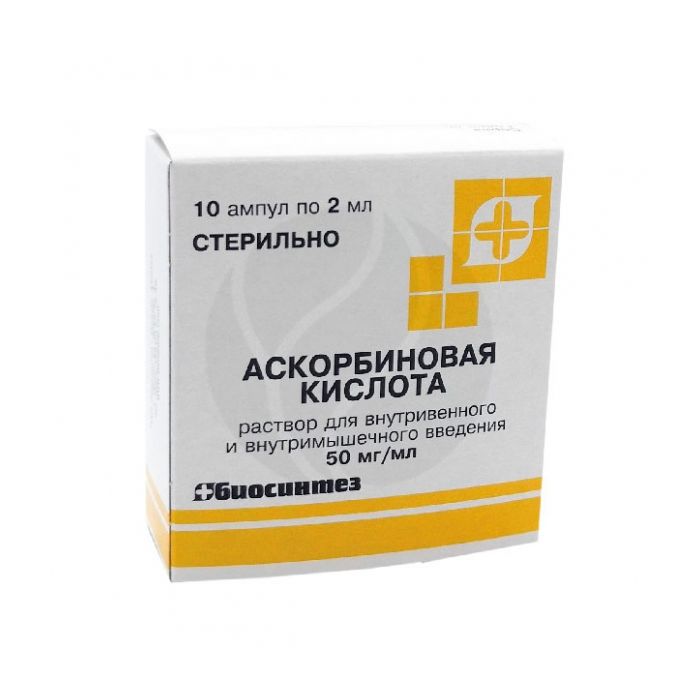Ascorbic acid solution 5%, 2ml No. 10
Expiration Date: 05/2027
Russian Pharmacy name:
Аскорбиновая кислота раствор 5%, 2мл №10
- Treatment of hypo- and avitaminosis C (if it is necessary to quickly replenish vitamin C and the impossibility of oral administration).
- Used for medicinal purposes in all clinical situations associated with the need for additional administration of ascorbic acid, including: parenteral nutrition, diseases of the gastrointestinal tract.
- In laboratory practice.
Applied as directed by a doctor.
Ascorbic acid is administered orally (after meals), intramuscularly or intravenously.
For prophylactic purposes, adults are prescribed 0.05 g-0.1 g per day; during pregnancy, in the postpartum period and in the case of a low content of vitamin C in the milk of lactating women, 0.3 g per day is prescribed for 10-15 days, after which, prophylactically, 0.1 g per day during the entire lactation period.
Children are prescribed prophylactically 0.025 g 2-3 times a day.
Therapeutic doses for adults are when taken orally - 05-0.1 g 3-5 times a day; for children - 0.05-0.1 g 2-3 times a day.
Therapeutic doses for adults with parenteral administration are 1-3 ml of a 5% solution (2-6 ml of a 2.5% solution) per day. Children are prescribed parenterally 1-2 ml of a 5% solution (2-4 ml of a 2.5% solution) per day. The course of treatment depends on the nature and course of the disease.
ascorbic acid 50 mg in 1 ml
- Hypersensitivity to the components of the drug,
- with long-term use in large doses (more than 500 mg) - diabetes mellitus,
- hyperoxaluria,
- nephrolithiasis,
- hemochromatosis,
- thalassemia,
- deficiency of glucose-6-phosphate hydrogenase.
With care:
Diabetes mellitus, glucose-6-phosphate hydrogenase deficiency, hemochromatosis, sideroblastic anemia, thalassemia, hyperoxaluria, kidney stones.
Indications:
- Treatment of hypo- and avitaminosis C (if it is necessary to quickly replenish vitamin C and the impossibility of oral administration).
- Used for medicinal purposes in all clinical situations associated with the need for additional administration of ascorbic acid, including: parenteral nutrition, diseases of the gastrointestinal tract.
- In laboratory practice.
Contraindications:
- Hypersensitivity to the components of the drug,
- with long-term use in large doses (more than 500 mg) - diabetes mellitus,
- hyperoxaluria,
- nephrolithiasis,
- hemochromatosis,
- thalassemia,
- deficiency of glucose-6-phosphate hydrogenase.
With care:
Diabetes mellitus, glucose-6-phosphate hydrogenase deficiency, hemochromatosis, sideroblastic anemia, thalassemia, hyperoxaluria, kidney stones.
Pregnancy and lactation:
The use of the drug during pregnancy and lactation is possible only as directed by a doctor if the intended benefit to the mother outweighs the potential risk to the fetus or baby.
Method of administration and dosage:
Intramuscularly, intravenously (slowly).
Adults from 100 to 500 mg (2 to 10 ml of 50 mg / ml solution) per day, in the treatment of scurvy - up to 1000 mg per day.
Children from 100 to 300 mg (2 - 6 ml of 50 mg / ml solution) per day, in the treatment of scurvy - up to 500 mg (10 ml of 50 mg / ml solution) per day.
Side effects:
From the side of the central nervous system: with rapid intravenous administration - headache, dizziness, fatigue; with prolonged use of large doses (more than 1 g) - headache, increased excitability of the central nervous system, insomnia.
From the urinary system: moderate pollakiuria (when using a dose of more than 600 mg / day), with prolonged use of large doses of hyperoxaluria, nephrolithiasis (from calcium oxalate), damage to the glomerular apparatus of the kidneys.
From the side of the cardiovascular system: with prolonged use of large doses - a decrease in capillary permeability (possible deterioration of tissue trophism, increased blood pressure, hypercoagulation, development of microangiopathies).
Allergic reactions: skin rash, skin flushing.
Laboratory indicators: thrombocytosis, hyperprothrombinemia, erythropenia, neutrophilic leukocytosis, hypokalemia, glucosuria.
Local reactions: soreness at the site of intramuscular injection.
Symptoms: nephrolithiasis, insomnia, irritability, hypoglycemia.
Treatment: symptomatic, forced diuresis.
Storage conditions:
In a dark place at a temperature of 5 to 25 ? C.
Keep out of the reach of children.
Expiration date:
1 year 6 months.
Do not use after the expiration date.
Pharmacy Dispensing Terms:
Prescription

